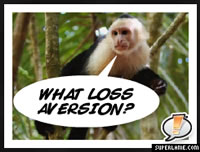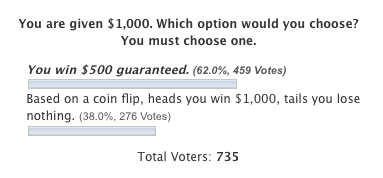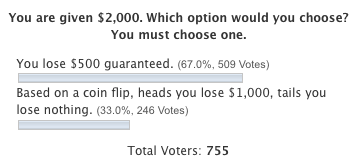 After two days of polling for my Are You Smarter Than a Monkey question, here are the results. As I revealed after voting, visitors were each served up one of two different poll questions randomly, with an equal chance of getting either one. This worked out pretty well, with 49%/51% split of voters.
After two days of polling for my Are You Smarter Than a Monkey question, here are the results. As I revealed after voting, visitors were each served up one of two different poll questions randomly, with an equal chance of getting either one. This worked out pretty well, with 49%/51% split of voters.


If you compare the questions side-by-side, you realize that they actually ask the exact same thing. Your two choices are essentially:
- $1,500 guaranteed, or a
- 50/50 chance at either $1,000 or $2,000
In statistics and gambling, there is a concept called expected value which is the probability-weighted sum of the possible values. In this case, the expected value for both options is $1,500. In other words, over many coin flips, the average person will get $1,500. So there is no “right” answer really, it’s more about how much risk you wish to take on. In general, you all would rather take the sure thing. I would be in this camp as well, but I’d probably take the risk if the expected value was a bit higher (remnants of blackjack self-training).
So if both polls are asking the same thing, a rational human being would answer both questions the same. However, psychologists have found that how the question is posed changes the answer. In the top poll, you start with $1,000 and are faced with either a sure gain or a bigger gain/nothing. In the bottom poll, you start with $2,000 and are faced with a sure loss or a bigger lose/nothing.
This small difference tries to test the phenomenon of loss aversion, which is the human tendency to strongly prefer avoiding losses rather than making gains. In this case, studies found humans hated the idea of losing $500 guaranteed so much that they’d take the risk in order to possibly avoid a loss, even though as we showed above the two choices are the same. Research with monkeys found that capuchin monkeys would also rather avoid the sure loss, indicating that this may be a genetic flaw rather than caused by our environment.
However, you guys were the complete opposite.
More people (38% versus 33%) went for the risky option when they had the $1,000. I don’t have any solid explanation for this, but here are some theories:
- Readers of this blog are exceptional and don’t have loss aversion, they are of the “nothing to lose anyway, let’s go for it” mindset.
- My testing was flawed. In the official studies, I am not sure if the same person was asked both questions, one after another. In retrospect, perhaps it would be better to present it in this manner.
- Readers were already aware of the loss aversion theory, and compensated when answering the poll.
- People either voted on both polls or multiple times on either poll, perhaps after reading the rest of the post explanation.
Either way, this was fun, and with nearly 1,500 voters, I’ll definitely try another experiment soon. 😉
 The Best Credit Card Bonus Offers – 2025
The Best Credit Card Bonus Offers – 2025 Big List of Free Stocks from Brokerage Apps
Big List of Free Stocks from Brokerage Apps Best Interest Rates on Cash - 2025
Best Interest Rates on Cash - 2025 Free Credit Scores x 3 + Free Credit Monitoring
Free Credit Scores x 3 + Free Credit Monitoring Best No Fee 0% APR Balance Transfer Offers
Best No Fee 0% APR Balance Transfer Offers Little-Known Cellular Data Plans That Can Save Big Money
Little-Known Cellular Data Plans That Can Save Big Money How To Haggle Your Cable or Direct TV Bill
How To Haggle Your Cable or Direct TV Bill Big List of Free Consumer Data Reports (Credit, Rent, Work)
Big List of Free Consumer Data Reports (Credit, Rent, Work)